Important Point
What Is a Pelton Turbine?
A turbine capable of operating under a high potential head of water is a Pelton wheel turbine that operates at a head over 300 meters. The runners consist of a circular disk with appropriate semi-elliptical cups known as buckets that are evenly positioned around its circumference.
One or more nozzles are placed so that each carries a jet along a tangent to the circles through the centers of the buckets, called the pitch circle. A cover is provided to prevent water splatter and the tailrace from discharging water.
The Pelton turbine is an impulse turbine named after an American engineer, Lester a. Pelton. Pelton turbines are suitable for energy extraction when water energy is available at a high head and low flow rate. In this type of turbine, the water potential and pressure energy are converted into kinetic energy.
Nozzles are used, which increases the velocity of water &, therefore, the kinetic energy. The Pelton wheel is a tangent flow turbine which means that the water jet will touch the turbine blade tangentially. This is a high-head turbine. This means that this turbine is used only in the situation where water is available at the high head.
A turbine whose head is very high has very little specific heat. So the turbine is also called a less specific heat turbine. It is also a low-discharge turbine.
Also, Read: What Is the Quick Return Mechanism? | Types of Quick Return Mechanism
Properties of Pelton Turbine:
- It is a tangent flow turbine.
- It is a high-head turbine.
- It is a less specialized heat turbine.
- It is a low-discharge turbine.
- The pressure in the inlet of the turbines is equal to the pressure in the outlet of the turbine. Therefore, this turbine does not have cavity problems.
Working of Pelton Turbine:
Water is stored at a high head & passes through the Penticton and reaches the nozzle of the Pelton turbine. After reaching the Pelton turbines, the kinetic energy of the water increases as it passes through the nozzle.
After that, the water strikes the bucket with high kinetic energy, this water exerts a force in the jet bucket, and this bucket is known as the impulse force. The flow of water from the nozzles is controlled using a spear fixed near the end of the nozzle. The wheel and turbine arrangement is used to regulate the flow of water through the nozzle.
When the spear is moving toward the nozzle, the water flow rate through the nozzle decreases, and when the spears are moved away from the nozzles, the water flow rate through the nozzles increases. When the water from the nozzles reaches the buckets of the turbine, the water splits into the bucket cup in two ways, and the speed of the water is transferred to the bucket of the turbine.
When the water exerts force on the turbine, the turbine starts rotating due to this impulse force. The splitting of the water into the cups helps to balance the turbine because the component of the force exhaled by the water is canceled after splitting because these components of the force are equal in magnitude & opposite in direction.
For maximum efficiency & power, the turbine is designed in such a way that the velocity of the water jet is twice the velocity of the water. After that, the main function is that of a generator that converts.
Also, Read: Parts and Functions of Grinding Machine | Grinding Machine | Grinding Machine Types
Parts of Pelton Turbine:
The various parts of Pelton turbine are: –
- Nozzle’s Flow Regulating Arrangement.
- Runner and Bucket.
- Casing.
- Brake Nozzle.
Also, Read: Working of Draft Tube | The Efficiency of Draft Tube | Types of Draft Tube
#1. Nozzle’s Flow Regulating Arrangement-
- Nozzle:- It is used to increase the kinetic energy of water.
- Penstock:- The penstock is a channel or pipe to deliver water to the Pelton turbine.
- Spear Arrangement:- The spear system is for regulating the flow of water. Since the turbine is coupled to the generator, sometimes, when the generator load is low, the turbine speed has to be reduced, and hence the water flow needs to be reduced. In this situation, the spear system is used to regulate and reduce the flow of water from the nozzle.
- A wheel exists to regulate the spear. When the nozzle spear is pushed forward towards the nozzle, the flow rate through the nozzle decreases, and when the nozzle spear is pulled away from the nozzle, the flow rate of the nozzle decreases.
Also, Read: Simple Indexing in Milling Machine
#2. Runner and Bucket-
- Runner:- The runner consists of a circular disk. Uniformly shaped and uniformly spherical buckets are mounted on this circular disk. If these buckets are not applied evenly, then the Pelton turbine will have a balance problem.
- Buckets:- In a Pelton turbine, each bucket can be of two shapes:
- Double hemisphere cup.
- Double ellipsoidal cup.
- In Pelton turbines, the vane or bucket is specially constructed such that the water will hit the center of the bucket and split into two streams, and the water will come out of the two pieces of the bucket.
- The materials used to make Pelton turbine buckets are cast iron, cast steel, bronze, or stainless steel.
- The material used to make the bucket is selected based on how high the water head is. If the water head is too high, very hard material is used to make the bucket.
- The line between two cups of a bucket or vanes is called a splitter. This tear divides the bucket into two parts, and these two parts are symmetrical.
- Also, a cut is placed on the underside of the buckets, ensuring that the water jet does not have to interfere with other old buckets.
- One of the most important parameters of the Pelton turbine design is the number of buckets on the disc. If the number of buckets is insufficient, it will result in a loss of water jet. With a small number of buckets, at some point of operation, a full water jet may be lost.
- This would drastically reduce the performance of Pelton turbines. So, there should be a reasonable number of buckets that will ensure that no one loses water.
Also, Read: What Is a Flame in Gas Welding? | Types of Flames in Gas Welding
#3. Casing-
- It prevents water splatter.
- It collects water & discharges it into the tech.
- It provides protection to the turbine.
Unlike other turbine casing, the Pelton turbine casing has no hydraulic function.
#4. Brake Nozzle-
- The braking jet that is inserted from the braking nozzle is used to stop the Pelton turbine in a short time.
- When the water supply to the Pelton turbines is shut down, the turbine still rotates and does not shut down due to inertia because the turbine components are made of heavy materials.
- If the situation arises when the turbine requires a full stop, this brake nozzle supplies the braking jet, and this braking jet hits the bucket in the opposite direction, and therefore the turbine stops because of the force in the opposite direction.
- In these Pelton turbines, there are two openings that help maintain pressure inside the turbine, which is equal to atmospheric pressure.
Also, Read: Open Belt Drive And Cross Belt Drive | Difference Between Open Belt Drive And Cross Belt Drive
Important Angles to Consider in Pelton Turbine:
- Total splitter angle:- The total splitter angle is the angle between two tangents drawn from the curve of the two cups near the splitters. It is denoted by 2βs.
- The splitter angles are half of the total splitter angle & are represented by βs.
- When water strikes the bucket, the water will exert force on the bucket, and as the water splits, the force is split in the x-direction & y-direction.
- But the y-direction forces of two cups will cancel each other out because they will be equal in magnitude & opposite in direction, but the forces in the x-direction of the two cups will combine and help rotate the turbine.
- Deflection Angle:- The deflection angles are the angle of deflection of water after the beak hit.
- If the deflection angle is 180 °, then the force exerted on the bucket is maximum. So, 180 ° is the ideal deflection angle.
- But we did not use the ideal deflection angle because when the ideal deflection angle is used, the water from the bucket is reflected with high force and collides with the opposite direction of the preceding bucket, and hence the force in the preceding bucket decreases.
- Because the forces are in the opposite direction, typically, a deflection angle between 165 ° to 170 ° is used for optimum efficiency.
- Inlet Angle:- In practice, the inlet angle is used between 1 ° to 3 °. But theoretically, all calculation is done by taking the inlet angle 0 °
Also, Read: EBM Machining | Principle of Electron Beam Machining | Working of Electron Beam Machining
Applications of Pelton Turbine:
Here, the different Applications of Pelton Turbine are as follows
- Pelton turbines are used where water is available at the hydroelectric power plant at 150 m to 2000 m high head.
- They are also used in laboratories of educational institutions.
Advantages of Pelton Turbine:
Here, the different Advantages of Pelton Turbine are as follows
- It is easy to maintain.
- Pelton turbine does not have cavity problems.
- Pelton turbine has a simple construction.
- It can operate at a high head and low discharge.
- It is very easy to assemble.
- The overall efficiency of this turbine is very high.
Disadvantages of Pelton Turbine:
Here, the different Disadvantages of Pelton Turbine are as follows
- Pelton turbines require very high heads for operation.
- Efficiency decreases quickly over time.
- Its turbine size is generally large and therefore requires large space.
- Since it only works in high heat, it is difficult to control the vibration in the operating head.
Frequently Asked Questions (FAQ)
Pelton Turbine
A Pelton turbine or Pelton wheel is a type of hydro turbine (specifically an impulse turbine) used frequently in hydroelectric plants. The operation of a Pelton turbine is fairly simple.
In this type of turbine, high-speed jets of water emerge from the nozzles that surround the turbine. These nozzles are arranged so the water jet will hit the buckets at splitters, the center of the bucket where the water jet is divided into two streams.
Like this post? Share it with your friends!
Suggested Read –
- Difference Between Orthogonal and Oblique Cutting | Orthogonal Machining
- Parts of Shaper Machine | What Is the Shaper Machine? | Working of Shaper Machine
- What Is a Synchromesh Gearbox? | Principle of Synchromesh Gearbox | Construction of Synchromesh Gearbox | Working of Synchromesh Gearbox
- Working of Constant Mesh Gearbox | What Is a Constant Mesh Gearbox? | Different Gear Ratios in Constant Mesh Gearbox | Construction of Constant Mesh Gearbox
- What Is Magneto Ignition System | How Does an Ignition System Work | How Does a Magneto Work | What Does a Magneto Do | Magneto Ignition System
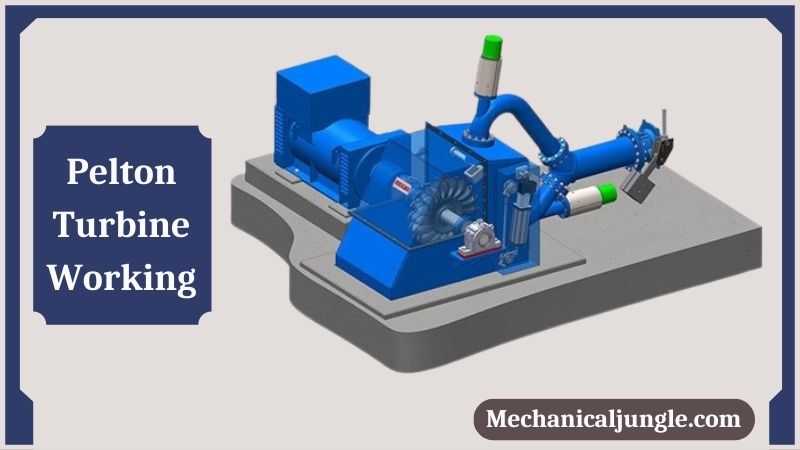
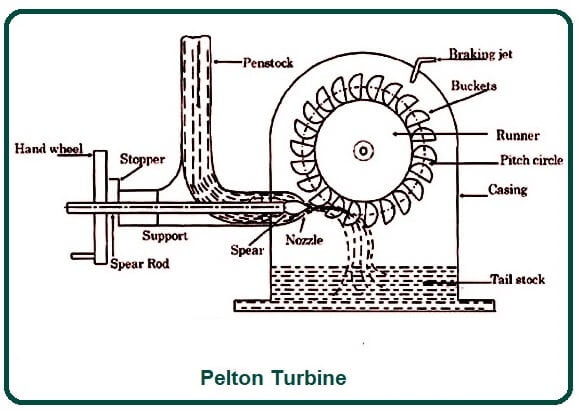
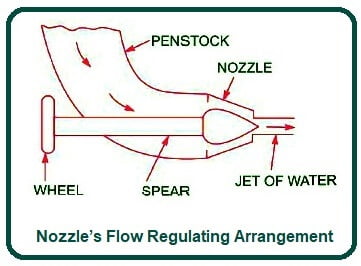
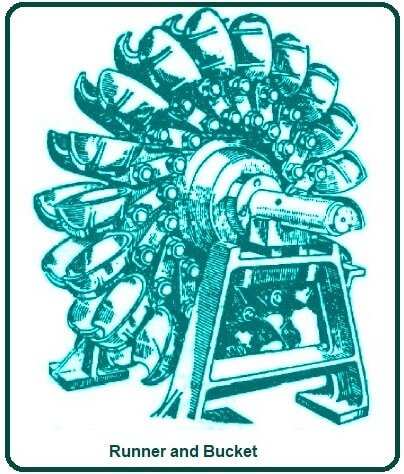
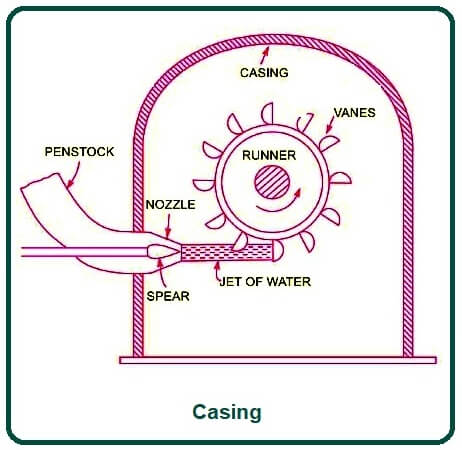

Leave a Reply